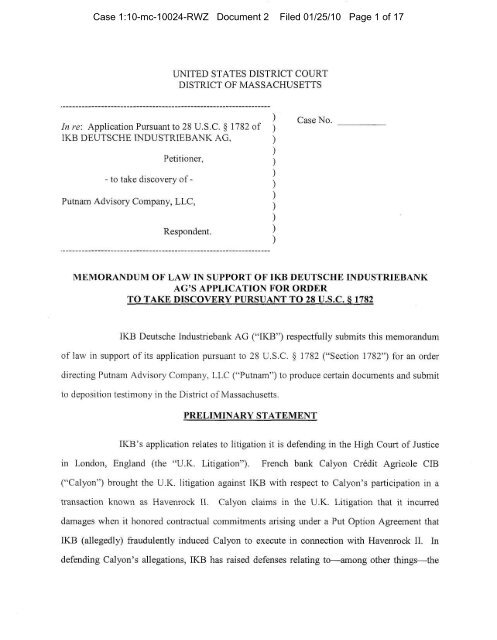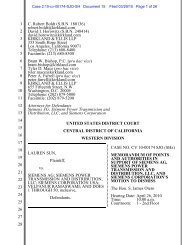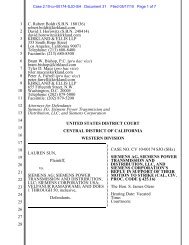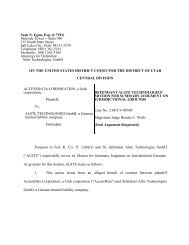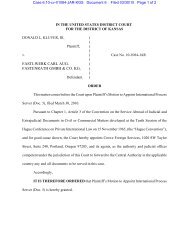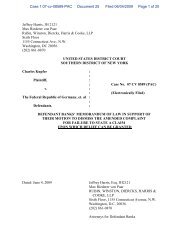IKB Memo ito support the Order
IKB Memo ito support the Order
IKB Memo ito support the Order
Create successful ePaper yourself
Turn your PDF publications into a flip-book with our unique Google optimized e-Paper software.
Case 1:10-mc-10024-RWZ Document 2 Filed 01/25/10 Page 1 of 17<br />
UNITED STATES DISTRICT COURT<br />
DISTRICT OF MASSACHUSETTS<br />
In re: Application Pursuant to 28 U.S.C. 5 1782 of<br />
<strong>IKB</strong> DEUTSCHE INDUSTRIEBANK AG,<br />
Case No.<br />
Petitioner,<br />
- to take discovery of -<br />
Putnam Advisory Company, LLC,<br />
1<br />
1<br />
1<br />
Respondent. )<br />
)<br />
)<br />
MEMORANDUM OF LAW IN SUPPORT OF <strong>IKB</strong> DEUTSCHE INDUSTRIEBANK<br />
AG'S APPLICATION FOR ORDER<br />
TO TAKE DISCOVERY PURSUANT TO 28 U.S.C. 6 1782<br />
<strong>IKB</strong> Deutsche Industriebank AG ("<strong>IKB</strong>") respectfully submits this memorandum<br />
of law in <strong>support</strong> of its application pursuant to 28 U.S.C.<br />
1782 ("Section 1782") for an order<br />
directing Putnam Advisory Company, LLC ("Putnam") to produce certain documents and submit<br />
to deposition testimony in <strong>the</strong> District of Massachusetts.<br />
PRELIMINARY STATEMENT<br />
<strong>IKB</strong>'s application relates to litigation it is defending in <strong>the</strong> High Court of Justice<br />
in London, England (<strong>the</strong> "U.K. Litigation").<br />
French bank Calyon Credit Agricole CIB<br />
("Calyon") brought <strong>the</strong> U.K. litigation against <strong>IKB</strong> with respect to Calyon's participation in a<br />
transaction known as Havenrock 11.<br />
Calyon claims in <strong>the</strong> U.K. Litigation that it incurred<br />
damages when it honored contractual commitments arising under a Put Option Agreement that<br />
<strong>IKB</strong> (allegedly) fraudulently induced Calyon to execute in connection with Havenrock 11. In<br />
defending Calyon's allegations, <strong>IKB</strong> has raised defenses relating to-among<br />
o<strong>the</strong>r things-<strong>the</strong>
Case 1:10-mc-10024-RWZ Document 2 Filed 01/25/10 Page 2 of 17<br />
various risks Calyon knowingly assumed in executing <strong>the</strong> Put Option Agreement and o<strong>the</strong>r<br />
Havenrock I1 agreements. Among those risks are those associated with certain collateralized<br />
debt obligation ("CDO") assets that Calyon structured, arranged and marketed-many<br />
of which<br />
ultimately became <strong>the</strong> subject of Calyon's obligations under <strong>the</strong> Put Option Agreement. JKB<br />
now seeks discovery from an entity-Putnam-that<br />
acted as collateral manager for a portion of<br />
those same CDO assets. <strong>IKB</strong> believes Putnam had substantial dealings with Calyon regarding its<br />
CDO business, including <strong>the</strong> structuring of those CDO assets and <strong>the</strong> analysis of <strong>the</strong> risks<br />
inherent in such investments.<br />
<strong>IKB</strong>'s application meets all of <strong>the</strong> statutory and discretionary requirements<br />
necessary to obtain discovery under Section 1782. As to <strong>the</strong> statutory requirements, <strong>IKB</strong> seeks<br />
discovery (i) from an entity (Putnam) whose headquarters are located in this district, (ii) for<br />
<strong>IKB</strong>'s use in defending a proceeding (<strong>the</strong> U.K. Litigation), (iii) that is pending in a foreign<br />
tribunal (London's High Court of Justice), (iv) in which <strong>IKB</strong> (as defendant) is an interested<br />
party. <strong>IKB</strong>'s application also meets <strong>the</strong> discretionary factors enunciated by <strong>the</strong> Supreme Court in<br />
Intel Corp. v. Advanced Micro Devices, Inc. and its progeny: (i) Putnam is not a party to <strong>the</strong> U.K.<br />
Litigation; (ii) <strong>the</strong> English courts are receptive to-and actually encourage-discovery under<br />
Section 1782 and <strong>IKB</strong>'s application is not an attempt to circumvent <strong>the</strong> High Court of Justice's<br />
proof-ga<strong>the</strong>ring requirements; and (iii) <strong>the</strong> discovery sought is nei<strong>the</strong>r unduly burdensome nor<br />
overly intrusive. Indeed, as set forth in <strong>the</strong> proposed order annexed to <strong>IKB</strong>'s application, <strong>the</strong><br />
discovery sought is limited to an eighteen-month period and involves only those Calyonarranged<br />
CDO transactions in which Putnam and Calyon were involved. The testimony and<br />
documents <strong>IKB</strong> seeks will assist <strong>the</strong> High Court of Justice to assess, on a fully-developed factual<br />
record (i) <strong>the</strong> risks that Calyon willingly assumed when it agreed to participate in <strong>the</strong> Havenrock<br />
11 transaction it claims to have been duped into entering into, and (ii) <strong>the</strong> extent and<br />
reasonableness of Calyon's alleged reliance on any representations by <strong>IKB</strong>, given Calyon's<br />
extensive experience in various roles in <strong>the</strong> CDO markets.
Case 1:10-mc-10024-RWZ Document 2 Filed 01/25/10 Page 3 of 17<br />
For all of <strong>the</strong>se reasons, and o<strong>the</strong>rs set forth more fully below, <strong>IKB</strong> respectfully<br />
submits that its application for discovery under Section 1782 should be granted.<br />
FACTUAL BACKGROUND<br />
The nature of <strong>the</strong> U.K. litigation for which <strong>IKB</strong> is seeking discovery-and<br />
Putnam's involvement in transactions relevant to that dispute-is<br />
described in detail in <strong>the</strong><br />
English pleadings attached at Exhibits ("Exhs.") B through E of <strong>the</strong> Declaration of Conrad<br />
Walker ("Walker Decl."). Below is a brief summary of <strong>the</strong> background of that case and certain<br />
facts relevant to <strong>IKB</strong>'s application here.<br />
The U.K. Litigation<br />
In <strong>the</strong> U.K. Litigation Calyon seeks to recover damages it allegedly suffered in<br />
connection with a transaction known as "Havenrock 11.'' Calyon makes allegations against <strong>IKB</strong><br />
in that action for breach of contract and <strong>the</strong> torts of deceit and negligent misstatement. Calyon<br />
contends-and <strong>IKB</strong> denies-that, among o<strong>the</strong>r things, (i) Calyon was fraudulently induced to<br />
participate in <strong>the</strong> Havenrock I1 transaction based on purported misrepresentations about <strong>IKB</strong>7s<br />
financial statements, (ii) IICB failed to negotiate <strong>the</strong> Havenrock I1 transaction in good faith, and<br />
(iii) IICB failed to inform Calyon of purportedly deficient risk management and reporting<br />
structures as to <strong>the</strong> portfolio of investments associated with <strong>the</strong> Rhineland Programme. (See<br />
generally Exh. C [Calyon's Particulars of Claim])<br />
In defending those allegations, <strong>IKB</strong> has challenged Calyon's assertions that it<br />
relied on <strong>IKB</strong>'s creditworthiness in accepting a guarantee from an entity known as FGIC-U.K.<br />
Limited ("FGIC-U.K.") under a Commitment Agreement related to Havenrock 11. <strong>IKB</strong> also<br />
placed into issue Calyon's knowledge of <strong>the</strong> risks associated with participating in Havenrock I1<br />
as well as pointing to Calyon7s own knowledge and experience in <strong>the</strong> areas of securitization and
Case 1:10-mc-10024-RWZ Document 2 Filed 01/25/10 Page 4 of 17<br />
structured credit and its involvement in developing structured products in relation to US subprime<br />
mortgage assets. <strong>IKB</strong> specifically identified Calyon's business relationship with Putnam<br />
(among o<strong>the</strong>rs) and its relevance to Calyon's allegations made in <strong>the</strong> U.K. Litigation. <strong>IKB</strong> has<br />
emphasized that-as part of Havenrock 11-Calyon executed a Put Option Agreement as part of<br />
and pursuant to Calyon's ambitions to become a significant player in <strong>the</strong> securitization and<br />
structured credit markets.<br />
<strong>IKB</strong> has also stressed <strong>the</strong> known market risks associated with<br />
Calyon's obligations under <strong>the</strong> Put Option Agreement. (Walker Decl. Exh. E [Summary of <strong>IKB</strong>'s<br />
Defence] at 77 41, 44-45). Such risks included those associated with CDO assets-like<br />
<strong>the</strong> ones<br />
for which Putnam acted as <strong>the</strong> collateral manager-that<br />
Calyon arranged and sold to certain<br />
purchasing entities (which <strong>the</strong>reafter became subject to Calyon's obligations under <strong>the</strong> Put<br />
Option Agreement). Caylon cannot complain-as it does in <strong>the</strong> U.K. Litigation-about <strong>the</strong> poor<br />
quality of <strong>the</strong> assets it received under <strong>the</strong> Put Option Agreement, since Calyon knew, or should<br />
have known, about <strong>the</strong> quality of many of those assets based on its involvement in arranging and<br />
selling <strong>the</strong>m. Indeed, Calyon itself sold $3 12.5 million of those CDOs that became subject to<br />
Calyon's obligations under <strong>the</strong> Put Option Agreement. (Walker Decl. Exh. D [Defence of <strong>IKB</strong>]<br />
at 7 26)<br />
Callvon9s Structured Finance Ambitions<br />
In 2005, Calyon set ambitious goals to develop and significantly diversify its<br />
activities in (1) securitization and (2) structured credit. That year, Calyon participated in major<br />
asset backed securitization issues in <strong>the</strong> United States as well as participating in transactions<br />
involving asset backed commercial paper ("ABCP") conduits. Calyon's structured credit activity<br />
accelerated in <strong>the</strong> second half of 2005 with its involvement in CDOs and <strong>the</strong> diversification of its
Case 1:10-mc-10024-RWZ Document 2 Filed 01/25/10 Page 5 of 17<br />
product offering to include innovative structures. (Walker Decl. Exhs. E [Summary of <strong>IKB</strong>'s<br />
Defence] at 7 16 & D [Defence of <strong>IKB</strong>] at 77 19-20)<br />
By 2006, Calyon had substantial expertise and depth in securitization and<br />
structured credit.<br />
To gain that expertise, Calyon acted as <strong>the</strong> arranger, placing agent and<br />
underwriter in respect of hundreds of millions of dollars worth of asset backed security ("ABS")<br />
CDOs. (Walker Decl. Exh. D [Defence of <strong>IKB</strong>] at 77 21-22) Calyon also knew that <strong>IKB</strong> acted<br />
as <strong>the</strong> adviser to certain special purchasing entities that purchased a substantial number of<br />
tranches of ABS and CDOs. Accordingly, Calyon tried to develop a close relationship with <strong>IKB</strong><br />
in order to sell CDOs to <strong>the</strong> purchasing companies <strong>IKB</strong> advised. (Id. at 7 23)<br />
As part of <strong>the</strong> process of arranging and selling CDOs, Calyon developed a<br />
business relationship with United States firm Putnam. Putnam acted as collateral manager to<br />
certain Calyon-arranged CDOs, including Pyxis ABS CDO 2006-1 ("Pyxis-1"), which closed on<br />
October 3, 2006. Calyon introduced and marketed to <strong>IKB</strong> portions of certain CDOs Calyon<br />
arranged. (Id. at 7 24)<br />
The Havenrock I1 Transaction<br />
In early June 2007, Calyon and certain of <strong>the</strong> purchasing entities that <strong>IKB</strong> advised<br />
(<strong>the</strong> "Loreley companiesn)' executed a series of agreements, collectively referred to as <strong>the</strong><br />
I<br />
The following Loreley Companies participated in Havenrock 11: Loreley Financing (Jersey)<br />
No. 1 Limited; Loreley Financing (Jersey) No. 2 Limited; Loreley Financing (Jersey) No. 3<br />
Limited; Loreley Financing (Jersey) No. 4 Limited; Loreley Financing (Jersey) No. 5 Limited;<br />
Loreley Financing (Jersey) No. 6 Limited; Loreley Financing (Jersey) No. 7 Limited; Loreley<br />
Financing (Jersey) No. 8 Limited; Loreley Financing (Jersey) No. 9 Limited; Loreley Financing<br />
(Jersey) No. 10 Limited; Loreley Financing (Jersey) No. 1 1 Limited; Loreley Financing (Jersey)<br />
No. 12 Limited; Loreley Financing (Jersey) No. 14 Limited; Loreley Financing (Jersey) No. 15<br />
Limited; Loreley Financing (Jersey) No. 16 Limited; Loreley Financing (Jersey) No. 17 Limited;<br />
Loreley Financing (Jersey) No. 18 Limited; Loreley Financing (Jersey) No. 19 Limited; Loreley<br />
Financing (Jersey) No. 22 Limited; Loreley Financing (Jersey) No. 23 Limited; Loreley
Case 1:10-mc-10024-RWZ Document 2 Filed 01/25/10 Page 6 of 17<br />
"Havenrock 11" transaction.<br />
One of those agreements was a Put Option Agreement, which<br />
provided <strong>the</strong> Loreley Companies with <strong>the</strong> option of putting to Calyon up to $2.5 billion in CDOs<br />
from Havenrock 11's portfolio of assets (<strong>the</strong> "Havenrock I1 Portfolio").<br />
In entering into that<br />
particular agreement, Calyon accepted <strong>the</strong> risk that, in <strong>the</strong> event <strong>the</strong> Loreley Companies were<br />
unable to obtain refinancing through <strong>the</strong> issuance of ABCP, those purchasing companies could<br />
put <strong>the</strong> Havenrock I1 Portfolio to Calyon at par. (Walker Decl. Exh. E [Summary of <strong>IKB</strong>'s<br />
Defence] at 77 21-22)<br />
Calyon attempted to mitigate that risk via (i) a Junior Credit Default Swap<br />
("JCDS"), whereby Havenrock I1 agreed to make payments to Calyon (upon receiving<br />
notification of certain defined credit events) for up to $625 million in potential losses under <strong>the</strong><br />
Put Option Agreement, and (ii) a Senior Credit Default Swap, whereby Havenrock I1 agreed to<br />
make payments to Calyon (upon receiving notification of certain defined credit events) for<br />
potential losses exceeding $625 million sustained under <strong>the</strong> Put Option Agreement. The JCDS<br />
was backed by two revolviilg loan agreements totaling $625 million from <strong>IKB</strong> and <strong>IKB</strong><br />
International SA ("<strong>IKB</strong> SA"). The SCDS was backed by a Commitment Agreement provided by<br />
FGIC-U.K., which is a subsidiary of Financial Guaranty Insurance Company ("FGIC-NY")<br />
(FGIC-NY and FGIC-U.K. collectively shall be referred to as "FGIC"). Under that Commitment<br />
Agreement, Calyon was <strong>the</strong> approved beneficiary of an obligation to issue a "Master Financial<br />
Guarantee" to guarantee Calyon's losses exceeding $625 million arising fi-om <strong>the</strong> assets put to<br />
Calyon under <strong>the</strong> Put Option Agreement. (Id. at 77 23-24)<br />
Financing (Jersey) No. 24 Limited; Loreley Financing (Jersey) No. 25 Limited; Loreley<br />
Financing (Jersey) No. 26 Limited; Loreley Financing (Jersey] No. 27 Limited; Loreley<br />
Financing (Jersey) No. 28 Limited; Loreley Financing (Jersey) No. 29 Limited; Loreley<br />
Financing (Jersey) No. 30 Limited; Loreley Financing (Jersey) No. 31 Limited; and Loreley<br />
Financing (Jersey) No. 32 Limited.
Case 1:10-mc-10024-RWZ Document 2 Filed 01/25/10 Page 7 of 17<br />
Prior to entering into <strong>the</strong> Put Option Agreement on June 8, 2007, in <strong>the</strong> course of<br />
2006 and 2007, Calyon marketed to <strong>IKB</strong> approximately $400 million and €100 million of CDOs.<br />
Calyon sold a significant number of CDOs that ultimately formed part of <strong>the</strong> Havenrock 11<br />
Portfolio. Indeed, $70 million of <strong>the</strong> $3 12.5 million in Calyon-arranged assets that formed a part<br />
of <strong>the</strong> Havel~rock I1 Portfolio consisted of CDOs for which Putnam was <strong>the</strong> collateral manager<br />
(i.e., Pyxis-1). (Walker Decl. Exh. D [Defence of <strong>IKB</strong>] at 77 25-26)<br />
Collapse of <strong>the</strong> ABCP Market<br />
In July 2007, equity and capital markets experienced considerable volatility due<br />
principally to <strong>the</strong> instability of <strong>the</strong> US sub-prime mortgage market and changes made by <strong>the</strong><br />
rating agencies in <strong>the</strong> methodology applied to rating ABS. By <strong>the</strong> beginning of August 2007, <strong>the</strong><br />
market for ABCP started to collapse because of a loss of investor demand for such securities. In<br />
<strong>the</strong>se market conditions, <strong>the</strong> Loreley Companies found it very difficult to refinance o<strong>the</strong>r than by<br />
invoking <strong>the</strong>ir rights under <strong>the</strong> Put Option Agreement.<br />
The Loreley Companies <strong>the</strong>refore<br />
exercised <strong>the</strong>ir rights under that contract and put $2.5 billion of assets to Caylon.<br />
Calyon <strong>the</strong>n sought payment from Havenrock I1 for its losses up to $625 million<br />
(which payments were financed by <strong>IKB</strong> and <strong>IKB</strong> SA under <strong>the</strong> two revolving loan agreements<br />
that backed <strong>the</strong> JCDS); <strong>IKB</strong> and <strong>IKB</strong> SA made those payments in full, <strong>the</strong>reby enabling<br />
Havenrock I1 to meet its payment obligations to Calyon under <strong>the</strong> JCDS. (Walker Decl. Exh. E<br />
[Summary of <strong>IKB</strong>'s Defence] at 77 29-31)<br />
For its anticipated losses above $625 million, Calyon, as beneficiary, sought<br />
payment from FGIC-U.K. as guarantor under <strong>the</strong> Commitment Agreement. Upon information<br />
and belief, FGIC-U.K. initially refused to make payment to Calyon, but-pursuant<br />
to a
Case 1:10-mc-10024-RWZ Document 2 Filed 01/25/10 Page 8 of 17<br />
settlement-Calyon<br />
accepted only $200 million from FGIC instead of <strong>the</strong> full $1.875 billion<br />
amount it was entitled to receive fi-om FGIC. (Id. at 7 32)<br />
Discovery in this District Relevant to <strong>the</strong> U.K. Litigation<br />
The relevant evidence suggests that since approximately 2001, Putnam's principal<br />
place of business has been in Boston, Massachusetts. (See Exh. A) <strong>IKB</strong> also has reason to<br />
believe that, in connection with <strong>the</strong> various CDO assets sold to <strong>the</strong> Loreley Companies, Putnam<br />
had routine communications and regularly exchanged documents with Calyon.<br />
Putnam is<br />
believed to be in possession of information regarding, among o<strong>the</strong>r things, (i) Calyon's<br />
ambitions in <strong>the</strong> securitization and structured credit markets, (ii) Calyon's assessment of <strong>the</strong> risks<br />
associated with <strong>the</strong> pools of assets that were included in <strong>the</strong> investment portfolios of <strong>the</strong> CDOs it<br />
arranged and marketed to <strong>IKB</strong>, (iii) <strong>the</strong> hedge positions placed by CDO participants with respect<br />
to CDOs arranged and sold by Calyon, and (iv) <strong>the</strong> practices of Calyon in structuring and<br />
marketing <strong>the</strong> CDOs for which Putnam acted as collateral manager, including its involvement in<br />
asset selection and nlanagement of <strong>the</strong> CDO's portfolio. All of that information, which <strong>IKB</strong><br />
seeks only as to an eighteen-month period, is for use in <strong>the</strong> U.K. Litigation.<br />
ARGUMENT<br />
<strong>IKB</strong> IS ENTITLED TO DISCOVERY<br />
FROM PUTNAM PURSUANT TO 28 U.S.C. 5 1782<br />
I. <strong>IKB</strong>'s APPLICATION MEETS ALL OF THE STATUTORY REQUIREMENTS<br />
FOR RELIEF PURSUANT TO 28. U.S.C. 5 1782<br />
Section 1782 of <strong>the</strong> Judicial Code authorizes federal district courts to assist foreign<br />
litigants, and o<strong>the</strong>r interested parties, in ga<strong>the</strong>ring evidentiary materiais for use in foreign iegai<br />
proceedings. See 28 U.S.C. 5 1782; see also In re Microsoft Corp., No. 06-10061, 2006 U.S.<br />
Dist. LEXIS 32577, at *9 (D. Mass. Apr. 17, 2006) (citing Intel Corp. v. Advanced Micro
Case 1:10-mc-10024-RWZ Document 2 Filed 01/25/10 Page 9 of 17<br />
Devices, Inc., 542 U.S. 241, 262 (2004)). The statute provides that a district court may order<br />
such discovery in response to an application by a party with an interest in a foreign legal<br />
proceeding:<br />
(a) The district court of <strong>the</strong> district in which a person resides or is<br />
found may order him to give his testimony or statement or to<br />
produce a document or o<strong>the</strong>r thing for use in a proceeding in a<br />
foreign or international tribunal, including criminal investigations<br />
conducted before formal accusation. The order may be made . . .<br />
upon <strong>the</strong> application of any interested person and may direct that<br />
<strong>the</strong> testimony or statement be given, or <strong>the</strong> document or o<strong>the</strong>r thing<br />
be produced, before a person appointed by <strong>the</strong> court . . . . The order<br />
may prescribe <strong>the</strong> practice and procedure, which may be in whole<br />
or part <strong>the</strong> practice and procedure of <strong>the</strong> foreign country or <strong>the</strong><br />
international tribunal, for taking <strong>the</strong> testimony or statement or<br />
producing <strong>the</strong> document or o<strong>the</strong>r thing.<br />
28 U.S.C. 1782. An order for discovery under Section 1782 is permitted where "[l] <strong>the</strong><br />
request is made by an interested party; [2] for material to be used in a foreign tribunal, and [3]<br />
<strong>the</strong> party for whom <strong>the</strong> request is made resides in <strong>the</strong> district in which <strong>the</strong> court sits." In re<br />
Microsoft, 2006 U.S. Dist. LEXIS 32577, at "8-9 (citing Intel, 542 U.S. at 255).<br />
<strong>IKB</strong>'s<br />
application easily meets <strong>the</strong>se three statutory requirements.
Case 1:10-mc-10024-RWZ Document 2 Filed 01/25/10 Page 10 of 17<br />
A. <strong>IKB</strong> Is An "Interested Party"<br />
<strong>IKB</strong> is an "interested party" within <strong>the</strong> meaning of Section 1782. As <strong>the</strong> Supreme Court<br />
recently held, litigants in <strong>the</strong> relevant foreign proceeding are "interested parties" under <strong>the</strong><br />
statute. Intel, 542 U.S. at 256; see also In re Microsoft, 2006 U.S. Dist. LEXIS 32577, at "9<br />
("As a litigant, Microsoft is an interested party."). In fact, as <strong>the</strong> Intel court noted, such litigants<br />
"may be <strong>the</strong> most common example of, <strong>the</strong> 'interested person[s]' who may invoke $ 1782."<br />
Intel, 542 U.S. at 256. Accordingly, <strong>IKB</strong>-as <strong>the</strong> defendant in <strong>the</strong> U.K. Litigation-is an<br />
"interested party" within <strong>the</strong> meaning of Section 1782.<br />
B. Discovery Sought Is "For Use In" A Foreign Tribunal<br />
The documents and deposition testimony <strong>IKB</strong> seeks from Putnam are "for use in" <strong>the</strong><br />
U.K. Litigation. Courts have held that <strong>the</strong> "for use in" provision "mirrors <strong>the</strong> requirements in<br />
Federal Rule of Civil Procedure 26(b)(l) and [refers to] discovery that is relevant to <strong>the</strong> claim or<br />
defense of any party, or for good cause, any matter relevant to <strong>the</strong> subject matter involved in <strong>the</strong><br />
foreign action."<br />
Fleischmann v. McDonald's Corp., 466 F. Supp. 2d 1020, 1029 (N.D. Ill.<br />
2006). This requirement does not require "an applicant to show that discovery is reasonably<br />
calculated to lead to evidence admissible in <strong>the</strong> foreign proceeding." Id. Indeed, courts have<br />
emphasized that discovery sought pursuant to Section 1782 need not be admissible or even<br />
discoverable in <strong>the</strong> foreign or international tribunal. Id. at 1026-29 ("'[F]or use in' does not have<br />
a foreign-discoverability nor a foreign admissibility requirement."); see also Intel, 542 U.S. at<br />
261 ("nothing in <strong>the</strong> text of 5 1782 limits a district court's production-order authority to<br />
materials that could be discovered in <strong>the</strong> foreign jurisdiction if <strong>the</strong> materials were located <strong>the</strong>re").<br />
Moreover, in considering Section 1782 applications, courts have stressed <strong>the</strong> need to keep in<br />
mind <strong>the</strong> "twin aims of <strong>the</strong> statute: providing efficient means of assistance to participants in<br />
international litigation in our federal courts and encouraging foreign countries by example to<br />
provide similar means of assistance to our courts . . . ." In re Metallgesellschaft AG, 121 F.3d 77,<br />
79 (2d Cir. 1997) (internal quotations omitted).
Case 1:10-mc-10024-RWZ Document 2 Filed 01/25/10 Page 11 of 17<br />
The documents and deposition testimony <strong>IKB</strong> seeks from Putnam are relevant to <strong>the</strong><br />
claims and defenses advanced in <strong>the</strong> U.K. Litigation and ordering <strong>the</strong>ir production will fur<strong>the</strong>r<br />
<strong>the</strong> "twin aims" of Section 1782. As set forth above, Calyon alleges in that action that, among<br />
o<strong>the</strong>r things, it was fraudulently induced to participate in <strong>the</strong> Havenrock I1 transaction and that<br />
<strong>IKB</strong> failed to inform Calyon of purportedly deficient risk management and reporting structures<br />
as to <strong>the</strong> Loreley Companies' portfolio of investments. <strong>IKB</strong>'s defense to those allegations has<br />
raised questions regarding (i) Calyon's ambitions to become a significant player in <strong>the</strong><br />
securitization and structured credit markets, (ii) Calyon's knowledge and understanding of <strong>the</strong><br />
risks associated with its participation in Havenrock I1 and <strong>the</strong> CDOs that were subject to <strong>the</strong> Put<br />
Option Agreement, (iii) <strong>the</strong> hedge positions placed by CDO participants with respect to CDOs<br />
arranged and sold by Calyon, and (iv) <strong>the</strong> practices of Calyon in structuring and marketing <strong>the</strong><br />
CDOs for which Putnam was collateral manager, including Calyon's involvement in asset<br />
selection and management of <strong>the</strong> CDO's portfolio. The risks Calyon assumed included those<br />
associated with CDO assets-like<br />
<strong>the</strong> ones in which Putnam was collateral manager-that<br />
Calyon arranged and sold to certain of <strong>the</strong> Loreley companies2 in 2006 and 2007. Those same<br />
assets ultimately became subject to Calyon's obligations under <strong>the</strong> Put Option Agreement. In<br />
connection with those CDO assets, Calyon likely had routine communications with Putnam and<br />
regularly exchanged documents with Putnam. <strong>IKB</strong> has reason to believe that, in <strong>the</strong> course of<br />
those exchanges, Putnam came into possession of information regarding, among o<strong>the</strong>r things,<br />
Calyon's market ambitions, its assessment of <strong>the</strong> assets acquired in connection with <strong>the</strong> CDOs it<br />
arranged and <strong>the</strong>reafter marketed to <strong>IKB</strong>, and Calyon's practices in structuring and marketing<br />
those CDO deals.<br />
Such information is highly relevant to <strong>the</strong> issues in dispute in <strong>the</strong> U.K.<br />
The Loreley Companies that purchased CDO assets from Calyon which ultimately were subject<br />
to Calyon's obligations under <strong>the</strong> Put Option Agreement included: ioreiey Financing (Jersey)<br />
No. 5 Limited; Loreley Financing (Jersey) No. 7 Limited; Loreley Financing (Jersey) No. 19<br />
Limited; Loreley Financing (Jersey) No. 22 Limited; Loreley Financing (Jersey) No. 23 Limited;<br />
Loreley Financing (Jersey) No. 25 Limited; and Loreley Financing (Jersey) No. 27 Limited.
Case 1:10-mc-10024-RWZ Document 2 Filed 01/25/10 Page 12 of 17<br />
Litigation, including <strong>IKB</strong>'s defense of that action. Moreover, as set forth above, ordering <strong>the</strong><br />
production of such information will aid <strong>the</strong> participants in <strong>the</strong> U.K. litigation by allowing <strong>the</strong>m to<br />
present a full factual record regarding several issues in dispute in that proceeding. In short, <strong>the</strong><br />
discovery <strong>IKB</strong> seeks from Putnam is properly sought "for use in" <strong>the</strong> U.K. Litigation, a<br />
traditional judicial proceeding that falls squarely within Section 1782. See 28 U.S.C. § 1782.<br />
Accordingly, <strong>IKB</strong>'s application meets <strong>the</strong> second statutory requirement, i.e., that <strong>the</strong> discovery<br />
sought is for use in a foreign tribunal.<br />
C. Putnam Resides And Can Be Found In The District Of Massachusetts<br />
Putnam resides and can be found in <strong>the</strong> District of Massachusetts for purposes of Section<br />
1782. In determining <strong>the</strong> location of an individual or entity from which discovery is sought<br />
pursuant to Section 1782, courts look to <strong>the</strong> place where <strong>the</strong> individual or entity resides. See In<br />
re Minatec Finance s.A'.R.L., No. 1 :08-cv-269, 2008 WL 3884374, at *4 (N.D.N.Y Aug. 18,<br />
2008) (holding where a company "maintains its primary office within <strong>the</strong> Nor<strong>the</strong>rn District of<br />
New York [it] obviously has been found within [its] jurisdiction"); In re OXUS Gold PLC, No.<br />
06-82, 2007 U.S. Dist. LEXIS 24601. at *8-10 (D.N.J. April 2, 2007). A business is considered<br />
"found" within <strong>the</strong> district in which its headquarters are maintained.<br />
In re Application of'<br />
Gerneinshcajtspmxis Dr. Med. SchottdorJ; No. Civ. M19-88, 2006 WL 3844464, at *4 (S.D.N.U.<br />
Dec. 29, 2006); see also In re Microsoft, 2006 U.S. Dist. LEXIS 32577, at "9 (respondent<br />
conceding it resides within federal district in which its headquarters were located). Putnam's<br />
principal place of business is in Boston, Massachusetts. (Walker Decl. at Exh. A) Putnam<br />
<strong>the</strong>refore maintains its headquarters in <strong>the</strong> District of Massachusetts, satisfying <strong>the</strong> third statutory<br />
element of Section 1782.<br />
11. THE DISCRETIONARY FACTORS WEIGH IN FAVOR OF GRANTING <strong>IKB</strong>'S<br />
APPLICATION<br />
If an applicant has met Section 1782's statutory requirements it is within <strong>the</strong> court's<br />
discretion to order <strong>the</strong> sought-after discovery. Intel, 542 U.S. at 255; see also In re Microsoft,
Case 1:10-mc-10024-RWZ Document 2 Filed 01/25/10 Page 13 of 17<br />
2006 U.S. Dist. LEXIS 32577, at "9. The Court's discretion must be exercised in light of <strong>the</strong><br />
"twin aims" of <strong>the</strong> statute described above. Intel, 542 U.S. at 252. In deciding to exercise its<br />
discretion, courts consider: (i) whe<strong>the</strong>r <strong>the</strong> person from whom discovery is sought is a participant<br />
in <strong>the</strong> relevant foreign proceeding who is subject to discovery in that jurisdiction; (ii) <strong>the</strong> nature<br />
of <strong>the</strong> foreign tribunal, <strong>the</strong> character of <strong>the</strong> proceedings underway, and <strong>the</strong> receptivity of <strong>the</strong><br />
foreign government, court or agency to federal-court judicial assistance, (iii) whe<strong>the</strong>r <strong>the</strong> Section<br />
1782 application conceals an attempt to circumvent foreign proof-ga<strong>the</strong>ring limits or o<strong>the</strong>r<br />
policies of a foreign country or <strong>the</strong> United States; and (iv) whe<strong>the</strong>r <strong>the</strong> discovery requests are<br />
unduly intrusive or burdensome. 11.1 re Microsoft, 2006 U.S. Dist. LEXIS 32577, at *9-10, 14<br />
(citing Intel, 542 U.S. at 264-65). Application of those discretionary criteria here militates in<br />
favor of <strong>IKB</strong>'s application.<br />
A. Putnam Is Not A Participant In The U.K. Litigation<br />
Putnam is not a participant in <strong>the</strong> U.K. Litigation, which weighs in favor of <strong>IKB</strong>'s<br />
application. The need for Section 1782 discovery is inore apparent when <strong>the</strong> person fiom whom<br />
discovery is sought is not a participant in <strong>the</strong> relevant foreign proceeding. Intel. 542 U.S. at 264.<br />
This discretionary factor recognizes that nonparties to a foreign proceeding, especially ilonparties<br />
that are not found in <strong>the</strong> jurisdiction of <strong>the</strong> foreign proceeding, are often difficult for those<br />
proceedings to reach directly. In re Mic~osoft, 2006 U.S. Dist. LEXIS 32577, at "9-10 (citing<br />
Intel, 542 U.S. at 264). Indeed, as <strong>the</strong> Microsoft court stressed, "[a] primary purpose of $<br />
1782(a) is '[tlo assist foreign tribunals in obtaining relevant information that <strong>the</strong> tribunals may<br />
find useful but . . . <strong>the</strong>y cannot obtain under <strong>the</strong>ir own laws."' In re Microsoft, 2006 U.S. Dist.<br />
LEXIS 32577, at *9 (citing Intel, 542 U.S. at 262). In short, it is appropriate for this court to<br />
exercise its discretion in favor of <strong>IKB</strong>'s application because Putnam is a non-party to <strong>the</strong> U.K.<br />
Litigation.
Case 1:10-mc-10024-RWZ Document 2 Filed 01/25/10 Page 14 of 17<br />
B. The U.K. Courts Are Receptive To Section 1782 Discovery<br />
The second discretionary factor <strong>support</strong>s <strong>IKB</strong>'s application because United Kingdom<br />
courts are receptive to Section 1782 discovery and <strong>IKB</strong> is not attempting to circumvent any<br />
English proof-ga<strong>the</strong>ring restrictions. As noted above, <strong>the</strong> U.K. Litigation is currently pending in<br />
London's High Court of Justice, Queen's Bench Division, Commercial Court. The High Court<br />
of Justice is very similar to trial courts here in <strong>the</strong> United States, in that <strong>the</strong>y have witness<br />
testimony and documentary evidence. See In re Application of Guy, No. M-19-96, 2004 WL<br />
1857580, at "2 (S.D.N.Y. Aug. 19, 2004). Accordingly, <strong>the</strong> High Court of Justice is well-suited<br />
to receive <strong>the</strong> testimony and documents that <strong>IKB</strong> is seeking to obtain from Putnam via this<br />
application.<br />
Courts customarily do not find a foreign tribunal to be unreceptive to judicial assistance<br />
from <strong>the</strong> United States, unless <strong>the</strong>re is authoritative proof from <strong>the</strong> foreign tribunal that it would<br />
reject evidence obtained through Section 1782. In re Euromepa S.A., 51 F.3d 1095, 1101 (2d<br />
Cir. 1995); see also In re Microsoft, 2006 U.S. Dist. LEXIS 32577, at *:I3 (quashing $ 1782<br />
subpoena because "it [was] made vividly clear that <strong>the</strong> Commission [did] not want <strong>the</strong> aid of this<br />
court").<br />
Here, <strong>the</strong>re is no authority suggesting that <strong>the</strong> government of <strong>the</strong> United Kingdom<br />
would be unreceptive to discovery obtained through a Section 1782 application. See, e.g., Irz re<br />
GLI~, 2004 WL 1857580, at *2 (finding no reason to believe that "<strong>the</strong> government of <strong>the</strong> United<br />
Kingdom would disfavor granting Applicants relief under S 1782.")<br />
Quite <strong>the</strong> contrary, <strong>the</strong><br />
House of Lords, <strong>the</strong> <strong>the</strong>n highest court of <strong>the</strong> United ICingdom, declared that even<br />
"nondiscoverability under English law did not stand in <strong>the</strong> way of a litigant in English<br />
proceedings seeking assistance in <strong>the</strong> United States under 5 1782." Intel, 542 U.S. at 262 (citing<br />
South Carolina Ins. Co. v. Assurantie Maatschappij "De Zeven Provincien " N. V., [I9871 1 A.C.<br />
24.) Simply put, because <strong>the</strong> United Kingdom is receptive to judicial assistance from <strong>the</strong> United<br />
States under Section 1782, <strong>the</strong> second discretionary factor weighs in <strong>IKB</strong>'s favor.
Case 1:10-mc-10024-RWZ Document 2 Filed 01/25/10 Page 15 of 17<br />
C. <strong>IKB</strong> is Not Attempting To Circumvent Any English Proof Ga<strong>the</strong>ring Restrictions<br />
In assessing <strong>the</strong> third discretionary factor, courts in this district consider whe<strong>the</strong>r an<br />
applicant's Section 1782 request conceals an attempt to circumvent foreign proof-ga<strong>the</strong>ring<br />
restrictions or o<strong>the</strong>r policies. In re Microsoft, 2006 U.S. Dist. LEXIS 32577, at "10. Absent bad<br />
faith on <strong>the</strong> part of a Section 1782 applicant, courts will not weigh this factor against granting <strong>the</strong><br />
discovery sought. In re Gemeinshcaftspraxis, 2006 U.S. Dist. LEXIS 94161, at "20. Moreover,<br />
litigants are not required to seek discovery through <strong>the</strong> foreign tribunal prior to seeking it from<br />
<strong>the</strong> district court. Id. (citing In re Euromepa, 51 F.3d at 1098). The London court hearing <strong>the</strong><br />
U.K. Litigation has taken no action to preclude <strong>IKB</strong> from seeking documents and testimony from<br />
Putnam. Moreover, <strong>IKB</strong> was not required to seek such discovery in London before making <strong>the</strong><br />
instant application. And as noted supm, <strong>the</strong> English courts are receptive to Section 1782<br />
discovery.<br />
In sum, <strong>the</strong> instant application is not an attempt by <strong>IKB</strong> to circumvent English<br />
discovery restrictions. Accordingly, <strong>the</strong> third discretionary factor favors <strong>IKB</strong>.<br />
D. The Discovery <strong>IKB</strong> Seeks Is Not Unduly Intrusive Or Burdensome<br />
The documents and deposition testimony sought from Putnam are not unduly intrusive or<br />
burdensome. "This factor directs <strong>the</strong> court to look at <strong>the</strong> requests in <strong>the</strong> aggregate to decide<br />
whe<strong>the</strong>r <strong>the</strong>y are unduly intrusive or burdensome." Fleischrnann, 466 F. Supp. 2d at 1032.<br />
(emphasis added). Courts simply look to whe<strong>the</strong>r <strong>the</strong> requests are "sufficiently tailored to <strong>the</strong><br />
litigation issues for which production is sought." In r-e Gemeinshcajtspmxis, 2006 U.S. Dist.<br />
LEXIS 94161, at "20; see also Fleischmann 466 F. Supp. 2d at 1033 (finding materials sought<br />
were relevant to claims and defenses and could be collected without undue burden.); In re<br />
Minatec, 2008 WL 3884374, at "8 (requests for materials under Section 1782 not unduly<br />
intrusive or burdensome as <strong>the</strong>y were "specifically and narrowly tailored to both [relevant] issues<br />
- tax liability and mislabeling"). The materials <strong>IKB</strong> seeks, as discussed supra, are relevant to<br />
<strong>IKB</strong>'s defenses to Calyon's claims in <strong>the</strong> U.K. Litigation. (See supra,<br />
I, B.) As explained in<br />
detail above, <strong>IKB</strong> seeks evidence from Putnam as to its knowledge of Calyon's ambitions in <strong>the</strong><br />
securitization market, its CDO structuring and marketing activities, and its assessment of <strong>the</strong>
Case 1:10-mc-10024-RWZ Document 2 Filed 01/25/10 Page 16 of 17<br />
risks associated with CDO assets it arranged (many of which ultimately became subject to<br />
Calyon's obligations under <strong>the</strong> Put Option Agreement it is challenging in <strong>the</strong> U.K. Litigation).<br />
Moreover, <strong>the</strong> discovery sought is limited to testimony and documents from an eighteen-month<br />
period (January 2006 through June 2007) and pertains only to those CDO transactions in which<br />
Calyon and Putnam were involved. (Walker Decl. at Exh. F [proposed subpoenas]) <strong>IKB</strong>'s<br />
application, <strong>the</strong>refore, is tailored to <strong>the</strong> litigation issues for which discovery is sought, i.e.,<br />
Calyon's market ambitions, its involvement with CDO assets that it ultimately received under <strong>the</strong><br />
Put Option Agreement, and Calyon's understanding of <strong>the</strong> risks attendant to its Havenrock I1<br />
obligations. Putnam, a sophisticated financial institution, should be able to-without<br />
any undue<br />
burden-collect<br />
<strong>the</strong> documents sought and provide testimony relevant to those issues and <strong>the</strong><br />
relevant transactions in which it participated with Calyon. Accordingly, <strong>the</strong> fourth discretionary<br />
factor weighs in <strong>IKB</strong>'s favor.<br />
For all of <strong>the</strong> reasons set forth above, <strong>IKB</strong>'s Section 1782 application satisfies both <strong>the</strong><br />
relevant statutory and discretionary factors and should be granted.
Case 1:10-mc-10024-RWZ Document 2 Filed 01/25/10 Page 17 of 17<br />
CONCLUSION<br />
For <strong>the</strong> foregoing reasons, <strong>IKB</strong> respectfully requests that this Court grant <strong>IKB</strong>'s<br />
application and enter <strong>IKB</strong>'s proposed order directing Putnam to produce documents and submit<br />
to deposition testimony for use in <strong>the</strong> U.K. Litigation, as set forth in <strong>the</strong> accompanying<br />
subpoenas.<br />
Dated: January 25, 201 0<br />
Respectfully submitted,<br />
<strong>IKB</strong> Deutsche Industriebank AG<br />
By - one of its attorneys,<br />
Pro Hac Vice Applications to Be Submitted:<br />
Zachary D. Rosenbaum<br />
Steven M. Hecht<br />
Thomas E. Redburn<br />
Scott L. Walker<br />
Hea<strong>the</strong>r C. Bishop<br />
Lowenstein Sandler PC<br />
65 Livingston Avenue<br />
Roseland, NJ 07068<br />
(973) 597-2500<br />
~a&el M. Brown (BBO # 667369)<br />
FOLEY HOAG LLP<br />
155 Seaport Blvd.<br />
Boston, MA 022 10<br />
Tel: (617) 832-1000<br />
Fax: (6 17) 832-7000<br />
rbrown@foleyhoag.com


